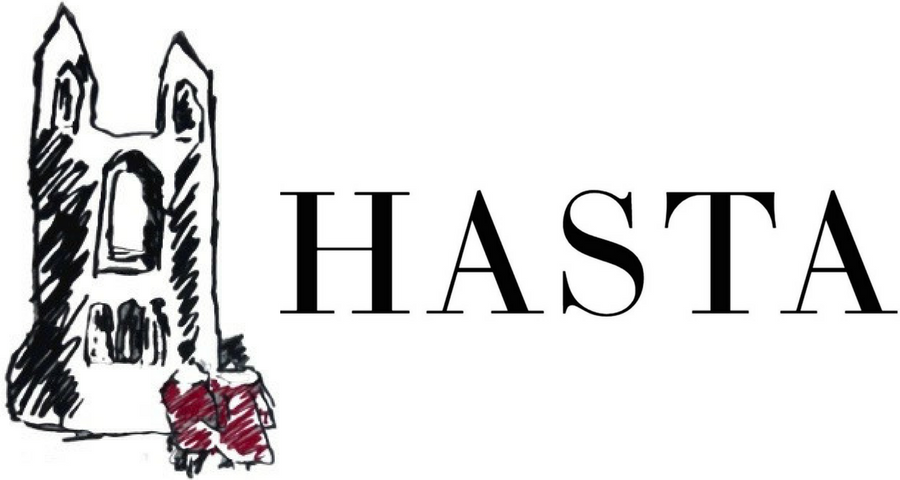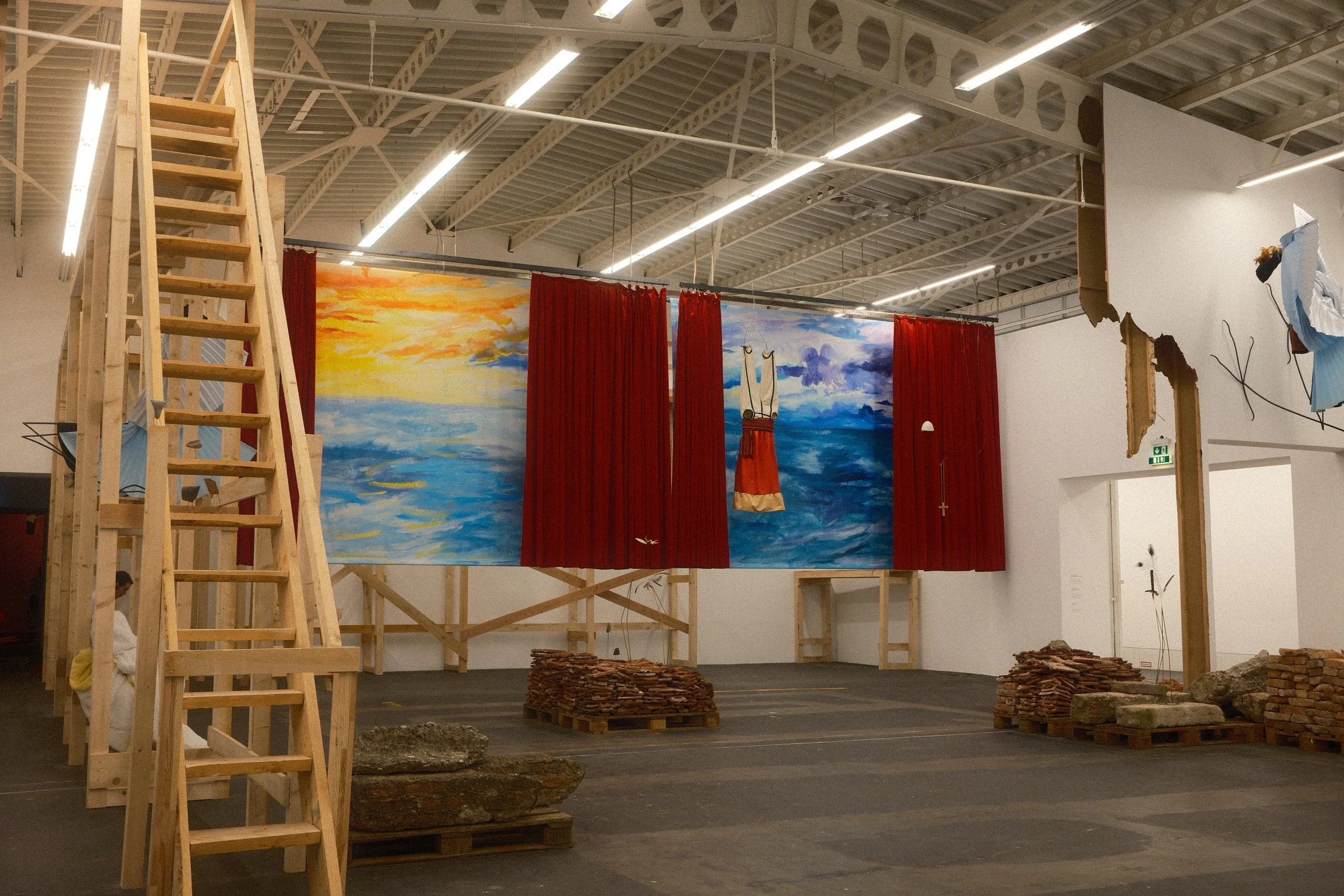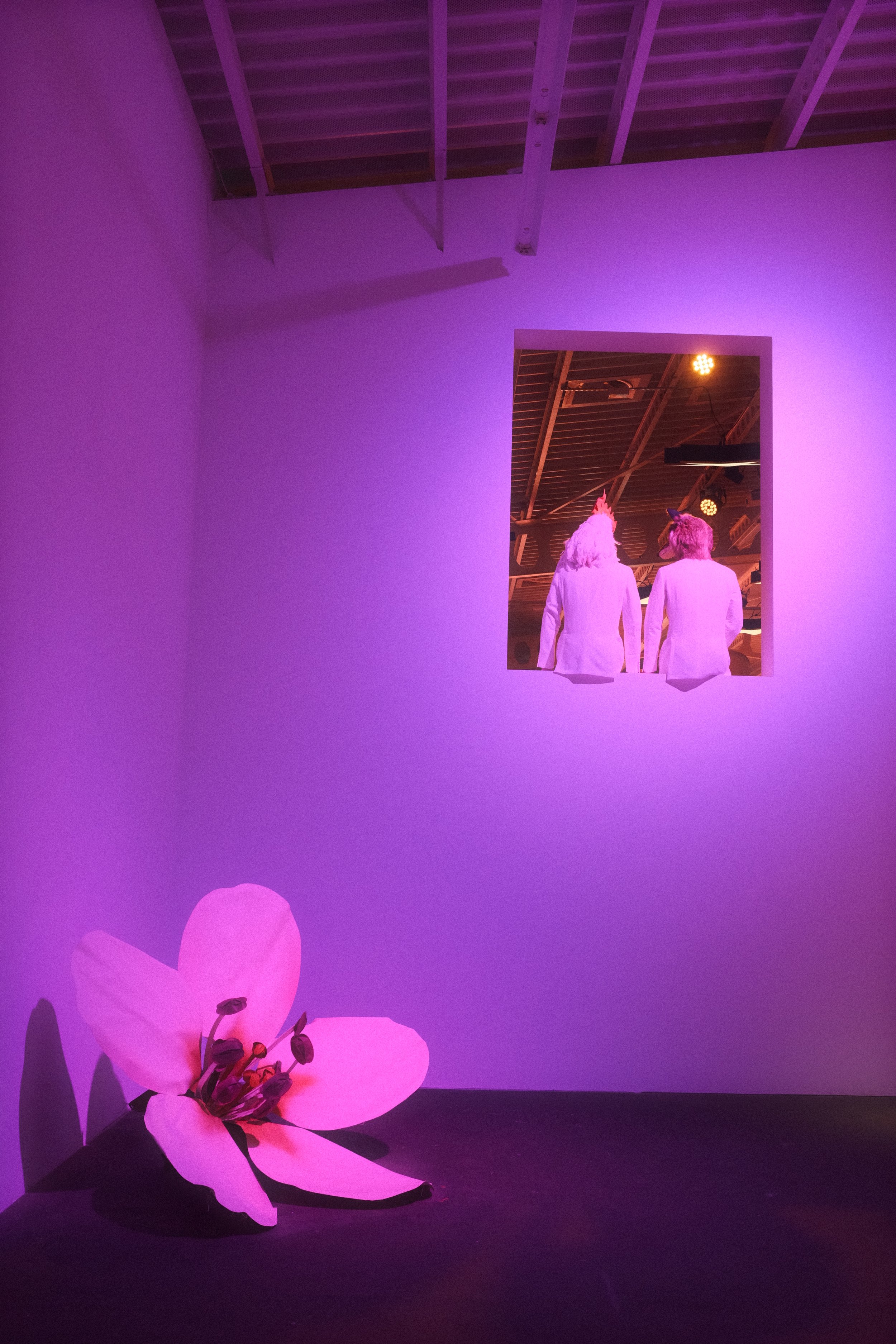Petrit Halilaj’s An Opera Out of Time: A Dreamscape of Freedom and Identity
By Grace Liang
Artist Petrit Halilaj’s exhibition at the Hamburger Bahnhof in Berlin, titled An Opera Out of Time, marries sculptures and installations from throughout his oeuvre. Entering the exhibition feels like trespassing into someone else’s dream. The atmosphere carries haunting memories, experiences, and queerness; an entire identity that is alien yet presented so that it is somehow familiar. The materials that he uses, many of which are found materials, bear the weight of exile while glowing with the hopeful optimism of imagination. His dreamscape is playful yet melancholy, intimate yet political, and folkloric yet futuristic. Halilaj does not shy away from these contradictions but rather embraces them. The artist blends the real and the material with the mythic and the imagined because to him, they are one in the same.
Petrit Halilaj, Syrigana, 2025.
Image courtesy of Grace Liang.
The Kosovo-born artist was forced to flee his home in the village of Runik at just twelve years old when it was burned down by the Serbians during the Kosovo War. While living in a refugee camp in Albania, psychologists gave the children paper and felt-tip markers to help work through their trauma, something that the artist cites as having saved his life. Halilaj had known that he was queer from a very early age, and he says that he ‘found this… river of expression and of being’ through that creative outlet that helped him to make sense of the trauma of displacement, along with the isolation of being a young gay man in a fraught political climate.
I was welcomed to the exhibition by textile moths made from traditional Kosovar rugs and other brightly coloured fabrics before entering a dark tunnel formed by sticks and twigs. Small birdlike creatures perch upon the branches, calling back to the archaeological discoveries at Runik, the village where the artist was raised. For RU (Aves Migrantis), Halilaj meticulously recreated dozens of Neolithic fragments that were taken from Kosovo and are housed today in the Serbian Ethnographic Museum. The artist combats the kidnapping and erasure of Kosovar history and culture by transforming the archaeological into the personal and reanimating these stolen artefacts into the form of birds. Flighted creatures have been an important motif in Halilaj’s works since his days drawing birds in the Albanian refugee camp. They have symbolised the freedom and hope that have been an important ideological throughline of his entire artistic career.
Petrit Halilaj, Shkrepëtima, 2018.
Image courtesy of Grace Liang.
On the other end of the tunnel, I emerged into Shkrepëtima (2018), an installation which found its origins in a performance in the ruins of the Kosovo House of Culture. The performance, made in collaboration with the entire local community, was put on to celebrate the memory of the House of Culture, which had once been home to a library, cinema, theatre, teahouse, and even an agricultural cooperative. The ruins of the building are seemingly represented in this iteration by the pallets of rubble and the half-deconstructed walls and structures. The curtains, stage, and costumes have been reassembled in a haunting echo of a theatre, feeling like the remnants of a civilisation that has long since passed. Yet, the project of rebuilding the House of Culture and, by extension, reviving the culture of the country itself is one that Halilaj is very involved in, even donating his $100,000 winnings from the prestigious Nasher Prize for Sculpture to the cause.
Petrit Halilaj, Syrigana, 2025.
Image courtesy of Grace Liang.
The rooms that follow begin the narrative of the five-part opera, Syrigana. The opera, made in collaboration with the Kosovo Philharmonic, reimagines the legend of Adam and Eve coming to the titular town of Syrigana after their exile from the Garden of Eden. Halilaj’s version depicts the corrupting fruit of the Tree of Good and Evil as a pear, with its pear blossoms representing queer love, rather than the more popular apple. Halilaj naturalises queerness as inherent to humanity and begs the question: What if creation itself were queer? The figures of Adam and Eve themselves have been subverted, now a Fox and a Rooster, both dressed in white groom suits. This follows the ancient archetypal tale of the Cock and the Fox but alters it to become a love story.
Petrit Halilaj, Syrigana, 2025.
Video courtesy of Grace Liang.
The hall hums with colour, light, and sound. A luminous red sun sets behind two avian figures, Birdy and Birda, who sit together having tea as stars twinkle overhead. The traditional Kosovar rugs reappear, this time forming a hill, a place from which viewers are invited to not just watch, but to inhabit the scene. Evocative and atmospheric music emanates through the room as the full opera soundtrack begins to play. The script for the stage production is projected onto the wall opposite the carpet mound and tells the story of Fox and Rooster’s entrance to Syrigana. They are brought in on KFOR helicopters, which are represented in the exhibition by sticklike sculptures based on children's drawings. The reference to the NATO-led peacekeeping force brings the artist’s lived experience back to the forefront of the scene, juxtaposing the twenty-first-century military vehicle with the folkloric landscape. The effect walks the line between fairytale and nightmare with the childlike rendering of a helicopter bearing the symbolism of invasion, rescue, and innocence simultaneously.
Halilaj’s folksy wonderland is populated by creatures that are not inhuman, but more than human. They surpass the limitations of humanity and exist in a paradise beyond the scope of our minds. Similarly, Halilaj’s works transcend categorisation and containment. He rejects the idea that mythology and imagination are merely useless fantasy and paints it for us as he knows it: a language for survival. His world of birds and foxes, suns and songs is not about returning to the past but about imagining how we may shape ourselves to honour it while evolving towards something better.
Leaving the exhibition, I thought of how opera has always been the art form of excess – excessive emotion, excessive drama, and even excessive makeup. Yet, Halilaj makes that excess his language. In his hands, opera becomes a shelter for the displaced, a queer utopia built out of twigs, carpets, and stars. For Halilaj, An Opera Out of Time is a vision of a world in which freedom is a long-sung promise rather than an aspiration.
Bibliography
“Petrit Halilaj ‘an Opera out of Time’ at Hamburger Bahnhof, Berlin — Mousse Magazine and Publishing.” 2025. Mousse Magazine and Publishing. October 2, 2025. https://www.moussemagazine.it/magazine/petrit-halilaj-hamburger-bahnhof-berlin-2025/.
Small, Zachary. 2025. “Petrit Halilaj Is the Winner of the Nasher Prize for Sculpture.” The New York Times, October 2, 2025. https://www.nytimes.com/2025/10/02/arts/design/petrit-halilaj-wins-nasher-prize-for-sculpture.html.
The Met. 2024. “Artist Interview—Petrit Halilaj: The Roof Garden Commission, Abetare | Met Exhibitions.” YouTube. May 3, 2024. https://www.youtube.com/watch?v=vfnvGS25Fu0.



